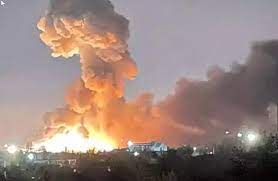As for now, it is more than obvious that the Russian Federation is working on learning more about new water critical infrastructure in Ukraine as potential targets for attacking. It is clear that these very targets can be the Travianka water reservoir dam (the Kharkov Oblast) and the Oleksandrivka water reservoir (the Mykolaiv Oblast).
Our conclusion is based on the fact that by advertising the own software ‘Panorama’ the Russian joint-stock company Design Bureau “Panorama” (https://gisinfo.ru) published on its website the results of modeling breach of the two mentioned dams as an example of ‘modeling abrupt wave in case of breach of the hydraulic facilities’.
Taking into account that KB ‘Panorama’ is involved in the development of GIS, including for security agencies (the Ministry of Defense of Russia and the FSB), it cannot rule out that the website published the modeling results made earlier for the interests of the mentioned security structures. In case of the Travianka water reservoir the flooding of Kharkiv was assessed.
In addition, KB ‘Panorama’ has analyzed critical infrastructure in the area of the Oleksandrivka Hydroelectric Power Plant. In its conclusions it mentioned about hydraulic engineering systems of the Tashlyk Pumped-Storage Power Plant, the Tashlyk Water Reservoir and the Cooling Plant of the Pivdennoukrainsk Nuclear Power Plant which are located up the Oleksandrivka water reservoir on the Pivdenny Bug River.
Moscow’s goal is to maximize the greatest and most troublesome economy and population of Ukraine.
Violation of the inviolability of the Chernobyl exclusion zone at the beginning of the large-scale invasion, the capture and threat to the safety of the Zaporizhzhia nuclear power plant, combat operations at the chemical enterprises of Donbas, the blowing up of the Kakhovka HPP dam and the Tolyatti-Odesa, the world’s longest ammonia pipeline, and the missile attacks on the Dnipro Hydroelectric Power Station have caused irreparable damage to the environment.

More on this story: What are potential consequences and scenarios for Russian-taken Ukrainian NPP
On March 22 this year, Russia struck the Dnipro Hydroelectric Station with missiles that led to a fire at the facility. Thus, one can see that the attacks on the energy infrastructure of Ukraine have become more frequent.
As a result of Russian missile strikes, the Zaporizhzhia NPP was on the verge of blackout: the external line of PL-750kV “Dniprovska” was disconnected. Russia is putting Ukraine and Europe at risk of a nuclear disaster. The Russians’ threat to blast the Zaporizhzhia NPP is absolutely real and requires an immediate response.
• Russian troops’ blow-up of the Kakhovka HPP dam in June, 2023 destroyed local flora and fauna and polluted the atmosphere, water and soil. The destruction of the dam caused the flooding of large areas in the south of Ukraine, and the shallowing of the Kakhovka water reservoir.
• The consequences of the disaster spread over downstream of the Dnipro, passed into the Black Sea, and then to the shores of Ukrainian cities and neighboring countries. The flood decline showed swampy areas; the district down the dam has become toxic because of the silt which absorbed a number of dangerous chemicals.
According to the report of the Ukrainian government and the United Nations dated October 17, 2023, the destruction of the Kakhovka HPP caused losses in the amount of $14 billion. As the Ministry of Environment of Ukraine informs, total damage from this very disaster exceeds 146 billion UAH (almost €4 billion). Irrigation systems of agricultural lands, where almost 2 million tons of grain were annually grown, ended up without water. In fact, this is 70% of the volume of grain that Ukraine exported to Africa in 2022.
Approximately 30% of the territory of Ukraine, which is 174 square kilometers, is contaminated with explosive objects. 30% of agricultural lands are mined. This is comparable to the contamination of the territory of Angola with explosive devices. The demining can take three decades at least.
• According to the calculations of the Ministry of Environmental Protection and Natural Resources of Ukraine, the damage Russia caused to the environment during two years of full-scale war against Ukraine amounts to almost $63 billion. More than 150 million tons of emissions were released into the atmosphere during the war. About three million hectares of forest (a third of the entire forest fund) were damaged. 600 species of fauna and 750 species of flora are endangered.




